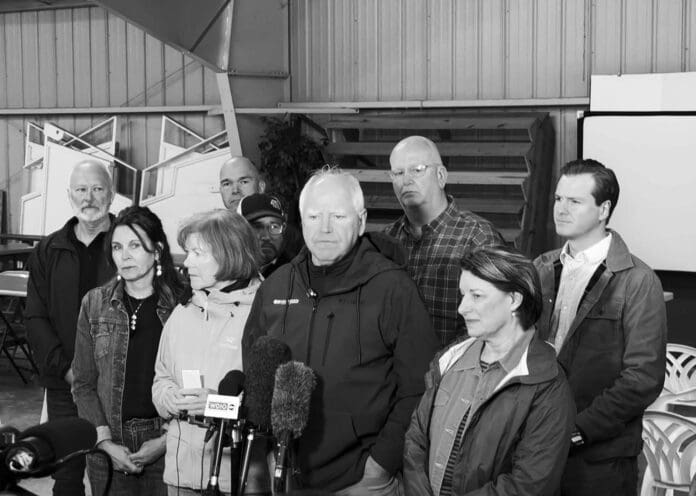In the wake of devastating wildfires that have scorched thousands of acres across Northern Minnesota over the past week, top state and federal leaders traveled to the Two Harbors and Brimson areas on May 17 to witness the damage firsthand, express gratitude to exhausted first responders, and underscore a strong commitment to recovery and rebuilding in the months ahead.
Governor Walz, joined by U.S. Senators Amy Klobuchar and Tina Smith as well as other state and federal officials, met with fire response leaders at the Incident Command Center in Two Harbors for a detailed briefing on the Camp House, Jenkins Creek, and Munger Shaw fires— three of the largest active wildfires currently burning in Minnesota.
“The fires across Northern Minnesota have forced families to evacuate and caused severe damage,” said Walz. “My thoughts are with those who have had to leave everything behind, and I extend my deepest gratitude to the wildland firefighters, first responders, volunteers, and emergency management officials who are working around the clock to contain these fires.”
Walz emphasized that Minnesota is prepared to respond swiftly to emergencies like wildfires, tornadoes, and flooding through its Disaster Contingency Account—a $50 million annual fund— reassuring residents that even if federal aid were delayed or unavailable, the state has the resources to act.
“Just to reassure folks on this—it’s hard, and we certainly know that it’s going to be traumatic over the coming months,” Walz added. “But the commitment to rebuilding is there.”
Senator Klobuchar acknowledged the unique challenges firefighters face in battling blazes across Minnesota’s vast and often remote forested landscapes, where access is difficult and conditions can change rapidly.
“I am always amazed at how isolated these forests can be and how difficult the job is to fight these fires,” she said. “Northern Minnesota is up to the task.”
State Senator Grant Hauschild also visited the Incident Command Center, offering thanks to firefighters and emphasizing the importance of continued coordination among local, state, and federal agencies in the response effort.
“As a legislator representing the most heavily forested regions in our state, I’m going to keep fighting for smart investments that prepare us for disasters like these and support rural fire departments year-round, not just in times of crisis,” Hauschild said.
The tour included a stop at my personal favorite local watering hole, Hugo’s B a r — t e m p o r a r i l y transformed into a hub of wildfire response. What’s normally a spot for burgers and beers had become a staging ground for firefighters, volunteers, and those affected by the fires. The community poured in with support: pallets of water and Gatorade, stacks of snacks, hot meals, bug spray—anything and everything responders and displaced families might need.
From the command center to Hugo’s Bar and beyond, the spirit of the Northland was evident at every stop. In the face of crisis, neighbors stepped up without hesitation and continue to ask what more they can do.
As Governor Walz later posted after the tour, “Glad to see some rain and a community that has each other’s back.”


